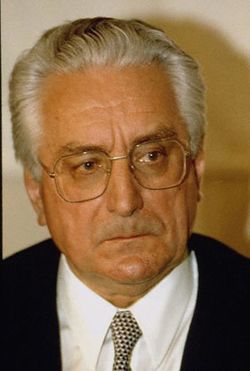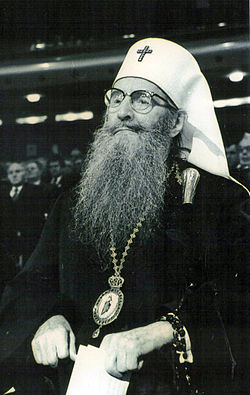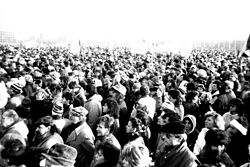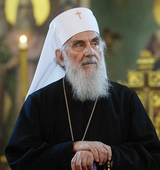Radushia
Sotirian Republic of Radushia Сацірскі Радауская Чува́шская Sacirski Radauskaja Respublika | |
|---|---|
Motto: Адзінства, Вера, Дысцыпліна "Adzinstva, Viera, Dyscyplina" Unity, Faith, Discipline | |
Anthem: Бог справедливости Bog Spravedlivosti God of Justice | |
| Capital and | Chrivotava |
| Official languages | Tavorstri |
| Recognised regional languages | Narodyn Volynian Belonarodyn |
| Ethnic groups (2016) | 88% Tavostri 6.3% Narozalic 3.1% Belonarodyn 1.9% Digoran |
| Religion | Epismalist Christianity |
| Government | Unitary dominant party theocratic parliamentary republic subject to a Supreme Patriarch |
| Macarius II | |
| Raman Yarmoshyn | |
| Tatsyana Holubeva | |
| Legislature | Great Assembly of State |
| Independence from Narozalica | |
• Declaration of independence | 3 August 1979 |
• Treaty of Boltovo | 1 May 1980 |
• Constitution of Saint Mikola | 6 July 1981 |
• Current constitution | 24 September 1992 |
| Area | |
• Total | 8,646 km2 (3,338 sq mi) |
| Population | |
• 2019 estimate | |
• 2016 census | 4,102,147 |
• Density | 485.04/km2 (1,256.2/sq mi) |
| GDP (PPP) | 2019 estimate |
• Total | |
• Per capita | |
| GDP (nominal) | 2019 estimate |
• Total | |
• Per capita | |
| Gini | 33.4 medium |
| HDI | 0.777 high |
| Currency | Radushian Zolota (RUZ) |
| Driving side | right |
| Internet TLD | .rd |
Radushia (Чува́шская; Radushiya), officially the Sotirian Republic of Radushia (Сацірскі Радауская Чува́уская; Sacirski Respublika Radushiya) is a landlocked country located in western Euclea, bordering Poliania to the west, Narozalica to the north, XX to the east and Lake XXX to the south. A small nation, it has a total area of 4,646 km² (3,338 sq mi) and a population of 4.91 million. It's capital is Detkovo and its largest city is Boltovo.
History...
History...
Today, Radushia is a member of the Community of Nations, ITO and the GIFA. Radushia is also a member of Samorspi. Despite it's size, Radushia holds significant cultural and religious influence, especially among nations of the Epistmalist Catholic Church. Radushia's economic growth and development has improved in recent years, with continued rise in living standards and incomes.
History
Pre-history
Ancient
Principality of Radushia (1085-1466)
Kingdom of Radushia (1466-1721)
Narozalic Empire (1721-1861)
Narozalic Republic (1861-1981)
TBD - loyal province.
TBD - loyal province.
TBD - loyal province.
TBD - loyal province - Radushian brigades during the GW...
Path to independence

Political crisis (1981-82)


Modern (1984-present)
Geography
Government and politics
According to the 1992 constitution, Radushia is a unitary theocratic parliamentary republic, subject to the authority of the Supreme Patriarch, who is the head of state and holds several executive powers. In addition to being the commander in chief of the armed forces, the Supreme Patriarch has the procedural duty of appointing the Chief Minister with the consent of the parliament, and has some influence on social policy. Marcarius II is the current Supreme Patriarch, while Raman Yarmoshyn of the All-Radushian Sotirian Party is the current Chief Minister. Many commentators also classify Radushia as a dominant party state, owing to the All-Radushian Sotirian Party winning every general election since 1981. However, Radushia is one of the highest ranking countries in Western Euclea for electoral standards.
The gvernment (Urada) is composed of the chief minister and cabinet ministers. The Government is responsible for proposing legislation and a budget, executing the laws, and guiding the foreign and internal policies.
The Great Assembly of State (Vialiki Asamblieja Dziaržavy) is a unicameral legislative body. The Great Assembly has the power to enact laws, approve the budget, schedule parliamentary elections, reccommend the appointment or dismissal of the Chief Minister and other ministers, declare war, and ratify international treaties and agreements. It is composed of 250 proportionally elected members who serve four-year terms.
Supreme Patriarch
The Supreme Patriarch, who assumes the office upon becoming Patriarch of the Radushian Epistmalist Church, is afforded several executive powers, yet shares many commonalities with ceremonial heads of states elsewhere. The Supreme Patriarch is granted the power to appoint and dismiss the Chief Minister and cabinet ministers, dissolve the Great Assembly and possesses a veto on all legislation (though this has been rarely used) which can be overturned with a two-thirds majority in the legislature. The Supreme Patriarch also has the responsibility of promulgation, with all legislature requiring his signature to enter law. The position is held for life in parallel to its religious counter-part.
One widely accepted feature of the office is the immense influence it holds over Radushian society, where comments and statements by the incumbent are regularly viewed as sacrosanct. As such, the Supreme Patriarch is able to influence the country socially without having to rely on legislation or law. This has been praised and criticised in equal measure due to the lack of accountability.
Role of the Radushian Epistmalist Church
Administrative divisions
Foreign relations
Armed Forces
Law
Economy
Demographics
| Historical population | ||
|---|---|---|
| Year | Pop. | ±% |
| 1956 | 2,974,122 | — |
| 1966 | 3,535,140 | +18.9% |
| 1976 | 4,416,898 | +24.9% |
| 1986 | 4,400,024 | −0.4% |
| 1996 | 4,225,871 | −4.0% |
| 2006 | 4,008,715 | −5.1% |
| 2016 | 4,193,694 | +4.6% |
| Source: Narozalic Census (1956-1976) Radushian State Census (1986-) | ||
Ethnic groups
Language
Religion

Healthcare
Education

Education in Radushia is split roughly equally between state-run and church-run institutions. Church schools tend to be of higher quality in teaching, learning content and are widely seen as more prestigious than state-run institutions. However, criticisms exist in that Church-shcools operate beyond government oversight and have little accountability. Anti-government critics have argued that church schools in Radushia are designed to "entrench support for the theocratic system, over preparing students for careers."
Urbanisation
Chirvotava, the nation's capital and largest city, was home to 1,117,900 residents in 2018, representing 26.65% of the national population. Ottseda, with a population of 181,000, is the second-largest city and is located on the shores of Lake XXX. Other large cities are Svaryn (165,100), Sviaty Michal (118,400), Sviaty Mikola (89,800) and Aleksandrina (78,300).
Largest cities or towns in Radushia
NBS (2019) | |||||||||
|---|---|---|---|---|---|---|---|---|---|
| Rank | County | Pop. | |||||||
 Chrivotava  Ottseda |
1 | Chrivotava | Chrivotava | 1,117,900 |  Svaryn  Sviaty Michal | ||||
| 2 | Ottseda | Sviokrava | 181,024 | ||||||
| 3 | Svaryn | Kvatory | 165,137 | ||||||
| 4 | Sviaty Michal | Sviaty Michal | 118,444 | ||||||
| 5 | Sviaty Mikola | Sviaty Mikola | 89,800 | ||||||
| 6 | Aleksandrina | Vidamlya | 78,365 | ||||||
| 7 | Harbacha | Harbacha | 61,364 | ||||||
| 8 | Solomyn | Solomyn | 51,701 | ||||||
| 9 | Novaya Antonovka | Sviaty Paviel | 50,988 | ||||||
| 10 | Staraya Vodva | Sviaty Džordž | 47,532 | ||||||









